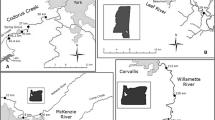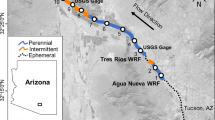Abstract
Experimentation using field-based artificial streams provides a promising, complimentary approach to biomonitoring assessments because artificial streams provide control over relevant environmental variables and true replication of treatments. We have used large and small artificial stream systems, based in the field, to examine the effect of treated bleached kraft pulp mill effluent (BKME) on the benthos of three large rivers in western Canada. Under natural regimes of temperature, water chemistry, and insolation, these artificial streams provide current velocities and substrata to food chains or food webs that are representative of those in the study river. With these tools we have shown that BKME stimulated mayfly growth in the Thompson River above that which could be accounted for by fertilization of their algal food supply. In contrast, moulting frequency was inhibited at high BKME concentrations. Results from artificial streams also indicate that increased algal biomass and abundances of benthic communities downstream of BKME outfalls were induced by nutrient enrichment from the effluent. BKME treatments did not change diatom species richness in the Fraser River, or diatom species diversity in either the Athabasca or Fraser Rivers. Artificial streams provide a means of understanding the mechanisms of stressor effects over a continuum ranging from single stressor effects on specific taxa to the effects of multiple stressors on communities and ecosystems. Because riverside deployment provides environmental realism within a replicated experimental design, this approach can (i) address questions that cannot be examined using laboratory tests or field observations, (ii) improve our mechanistic understanding of stressor effects on riverine ecosystems, and (iii) can contribute directly to the development, parameterization, and testing of models for predicting ecosystem-level responses.
Similar content being viewed by others

References
American Public Health Association, American Water Works Association, and Water Pollution Control Federation (APHA), 1985. Standard methods for the examination of water and wastewater. 14th edition. Washington, D.C.
Anderson, A. M., 1989. An assessment of the effects of the combined pulp mill and municipal effluents at Hinton on the water quality and zoobenthos of the Athabasca River. Environmental Assessment Division Report, Alberta Environment.
Buikema, A. & J. R. Voshell, 1993. Toxicity studies using freshwater benthic macroinvertebrates. In: D. M. Rosenberg & V. H. Resh (eds),Biomonitoring and benthic invertebrates. pp. 340–395. Chapman and Hall, New York.
Cooper & Barmuta, 1993. Field experiments in biomonitoring. In: D. M. Rosenberg & V. H. Resh (eds),Biomonitoring and benthic invertebrates. pp. 399–441. Chapman and Hall, New York.
Culp, J. M., Walde, S. J. & R. W. Davies, 1983. Relative importance of substrate particle size and detritus to stream benthos microdistribution. Canadian Journal of Fisheries and Aquatic Sciences 40: 1568–1574.
Culp, J. M. & K. J. Cash, 1995. Potential impacts of effluents on the Thompson and upper Fraser rivers: Progress Report for the Fraser River Action Plan.
Culp, J. M. & C. L. Podemski, 1995. Design and application of a novel stream microcosm system for assessing effluent impacts to large rivers (in press). In: M. R. Servos, K. R. Munkittrick, J. H. Carey & G. J. Van Der Kraak (eds),Fate and effects of pulp and paper mill effluents. St. Lucie Press, Boca Raton, Florida.
Forbes, V. E. & T. L. Forbes, 1994.Ecotoxicology in Theory and practice. Chapman and Hall, New York.
Guckert, J. B., 1993. Artificial streams in ecotoxociology. In: G. A. Lamberti & A. D. Steinman (eds),Research in artificial streams: Applications, uses, and abuses. pp. 350–356. Journal of the North American Benthological Society 12: 313–384.
Kimball, K. D. & S. A. Levin, 1985. Limitations of laboratory bioassays: The need for ecosystem-level testing. BioScience 35: 165–171.
Kosinski, R. J., 1989. Artificial streams in ecotoxicological research. In: A. Boudou and F. Ribeyre (eds),Aquatic ecotoxicology: Fundamental concepts and methodologies, Volume I. pp. 297–316. CRC Press, Boca Raton, Florida.
Hurlbert, S. J., 1984. Pseudoreplication and the design of ecological field experiments. Ecological Monographs 54: 187–211.
Lamberti, G. A. & A. D. Steinman, 1993. Introduction. In: G. A. Lamberti & A. D. Steinman (eds),Research in artificial streams: Applications, uses, and abuses. pp. 314–317. Journal of the North American Benthological Society 12: 313–384.
Lowell, R. B., J. M. Culp & F. J. Wrona, 1995a. Toxicity testing with artificial streams: effects of differences in current velocity. Environmental Toxicology and Chemistry 14: 1209–1217.
Lowell, R. B., J. M. Culp & F. J. Wrona, 1995b. Stimulation of increased short-term growth and development of mayflies by pulp mill effluent. Environmental Toxicology and Chemistry 14: 1529–1541.
Lowell, R. B., J. M. Culp & F. J. Wrona, 1995c. Effects of pulp mill effluent on benthic freshwater invertebrates: Food availability and stimulation of increased growth and development (in press). In: M. R. Servors, K. R. Munkittrick, J. H. Carey & G. J. Van Der Kraak (eds),Fate and effects of pulp and paper mill effluents. St. Lucie Press, Boca Raton, Florida.
McIntire, C. D., 1993. Historical and other perspectives of laboratory stream research. In: G. A. Lamberti & A. D. Steinman (eds),Research in artificial streams: Applications, uses, and abuses. pp. 318–323. Journal of the North American Benthological Society 12: 313–384.
Perez, K. T., 1995. Role and significance of scale to ecotoxicology. In: J. Cairns & B. R. Niederlehner (s),Ecological toxicity testing: Scale, complexity and relevance. pp. 169–191. Lewis Publishers, Boca Raton, Florida.
Podemski, C. L. & J. M. Culp, 1995. Nutrient and contaminant effects of bleached kraft mill effluent on benthic algae and insects of the Athabasca River, AB, Canada (in press). In: M. R. Servos, K. R. Munkittrick, J. H. Carey & G. J. Van Der Kraak (eds),Fate and effects of pulp and paper mill effluent. St. Lucie Press, Boca Raton, Florida.
Pontasch, K. W., 1995. The use of stream microcosms in multispecies testing. In: J. Cairsn & B. R. Niederlehner (eds),Ecological toxicity testing: Scale, complexity and relevance. pp. 169–191. Lewis Publishers. Boca Raton, Florida.
Smith, E. P., D. R. Orvos & J. CairnsJr. 1993. Impact assessment using the before-after-control-impact (BACI) model: Concerns and comments. Canadian Journal of Fisheries and Aquatic Sciences 50: 627–637.
Stewart-Oaten, A., W. W. Murdoch & K. R. Parker, 1986. Environmental impact assessment: “Pseudoreplication” in time. Ecology 67: 929–940.
Stewart-Oaten, A., J. R. Bence & C. W. Osenberg, 1992. Assessing effects of unreplicated perturbations: No simple solutions. Ecology 67: 929–940.
Swift, M. C., N. H. Troelstrup, Jr., N. E. Detenbeck & J. L. Foley, 1993. Large artificial streams in toxicological and ecological research. In G. A. Lamberti & A. D. Steinman (eds),Research in artificial streams: Applications, uses, and abuses. pp. 359–366. Journal of the North American Benthological Society 12: 313–384.
Underwood, A. J., 1994. On beyond BACI: sampling designs that might relably detect environmental disturbances. Ecological Applications 4: 3–15.
TAEM, 1993. Biological and water quality survey of the Athabasca River, October 1992. Prepared for Weldwood of Canada Ltd. Hinton, AB.
Author information
Authors and Affiliations
Rights and permissions
About this article
Cite this article
Culp, J.M., Podemski, C.L., Cash, K.J. et al. Utility of field-based artificial streams for assessing effluent effects on riverine ecosystems. Journal of Aquatic Ecosystem Health 5, 117–124 (1996). https://doi.org/10.1007/BF00662800
Received:
Accepted:
Issue Date:
DOI: https://doi.org/10.1007/BF00662800



